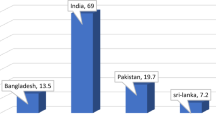Abstract
This paper examines the extent of change and stability in the population of UK firms through time in terms of its size distribution, as defined by number of employees. It was empirically found that the distribution of employment by firm size remained surprisingly constant over the 1987–1989 period. A major implication of this finding is that in times of very high net job creation (involving high gross job creation and loss), factors are at work in the economy to keep the population distribution of firms (in terms of employment concentrations) more or less stable. It is hypothesised that a ‘natural’ concentration exists for each different size band, and that as change takes place, the proportion of total employment based in the size band will tend towards this natural level.
The rise in the proportion of employment in small firms, and the comparatively high job creation ability of small firms in recent times has come about in part because of negative rather than positive macro-economic influences. In recession, small firms in aggregate in spite of their individual volatility, are the most resilient. In prosperous times they do not increase their proportion of employment share, while in times of recession they do. Our results imply that large firms have a very significant, if not the most significant, bearing upon aggregate employment trends. On the other hand, small firms inherently have more potential to create jobs than large firms.
The majority of public expenditure and legislative support for UK business is directed at large firms, as a result of culture and tradition. Even with the benefit of this support, large firms in recent decades have still performed badly, in job generation terms. In contrast, small firms have shown an inherent advantage in their ability to create jobs. A shift of government expenditure and legislative support from large to small firms would further enhance and realise the potential of small firms to benefit the economy and create jobs.
Similar content being viewed by others
References
Acs, Zoltan J. and David B. Audretsch (eds), 1990,The Economics of Small Firms: A European Challenge, Doredrecht: Kluwer Academic Publishers.
Bannock, Graham and Partners, 1989,Small Business Statistics: A Feasibility Study for the Department of Employment, London: Graham Bannock and Partners Ltd, December 1989.
Batstone, Stephen V., V. Galt and S. Heasall, 1988, ‘Evolution, Uncertainty and the Small Firm’, Paper presented to the 11th UK small firms policy and research conference.
Birch, David L., 1987,Job Creation in America, New York: The Free Press.
Bolton, John F., 1971,Small Firms: Report of the Committee of Enquiry on Small Firm, London: HMSO.
Daly, Michael, J., Martin Campbell, Geoffrey B. Robson and Colin C. Gallagher, 1991, ‘Job Creation 1987–89: The Role of Small and Large Firms’,Employment Gazette Nov.
Daly, Michael, J., Martin Campbell, Geoffrey B. Robson and Colin C. Gallagher, 1992, ‘Job Creation 1987–89: Preliminary Analysis by Sector’,Employment Gazette, Nov.
Doyle, John R. and Colin C. Gallagher, 1987, ‘The Size Distribution, Growth Potential, and Job Generation Contribution of UK Firms’,International Small Business Journal 6(1), 31–57.
Gallagher, Colin C. and John R. Doyle, 1986, ‘Job Generation Research: A Reply to Storey and Johnson’,International Small Business Journal 4(4), 47–55.
Gallagher, Colin C., Michael J. Daly and Jeremy C. Thomason, 1991, ‘The Growth of UK Companies 1985–87 and their Contribution to Job Generation’,Small Business Economics 3(2), 269–286.
Gallagher, Colin C. and Henry Stewart, 1986, ‘Jobs and the Business Life Cycle in the UK’,Applied Economics 18(8), 875–900.
Peters, Thomas J. and Robert H. Waterman Jr, 1982,In Search of Excellence: Lessons from America's Best-Run Companies, London: Harper Collins Publ.
Robson Geoffrey B., 1992,Job Generation in the UK: Dynamics of Employment Change in Small and Large Firms, Ph.D. Thesis University of Newcastle upon Tyne.
Robson Geoffrey B. and Colin C. Gallagher, 1992,An Evaluation of the Dun and Bradstreet Database for Job Generation Research, Research Report, Management Division, University of Newcastle upon Tyne, March.
Schwalbach, Joachim, 1990, in Acs Zoltan J. and David B. Audretsch (eds),The Economics of Small Firms: A European Challenge, Dordrecht: Kluwer Academic Publishers.
Schumpeter Joseph A., 1943,Capitalism, Socialism and Democracy, London: Allen and Unwin Publ.
Stanworth John and Colin Gray (eds), 1991,Bolton: 20 Years on, The Small Firm in the 1990s, London: Paul Chapman Publishing.
Storey David J. and Stephen Johnson, 1986, Job Generation in Britain: A Review of Recent Studies,International Small Business Journal 4(4), 29–47.
Storey David J. and Stephen Johnson, 1987,Job Generation and Labour Market Change, Macmillan.
Author information
Authors and Affiliations
Rights and permissions
About this article
Cite this article
Robson, G.B., Gallagher, C.C. Change in the size distribution of UK firms. Small Bus Econ 6, 299–312 (1994). https://doi.org/10.1007/BF01108397
Accepted:
Issue Date:
DOI: https://doi.org/10.1007/BF01108397




